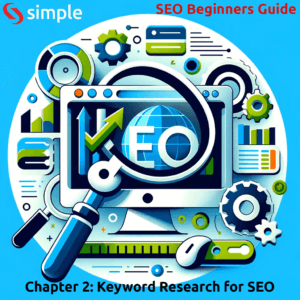Introduction
In this first chapter of our SEO Beginners Guide, we will look at search engines and SEO concepts.
In the world of digital marketing, grasping the fundamentals of how search engines work is crucial. This understanding not only illuminates the path to effective Search Engine Optimization (SEO) but also forms the foundation of a successful online presence.
Search Engines and SEO
The Goal of SEO
The primary goal of Search Engine and SEO is to increase a website’s visibility in search engine results, thereby attracting more organic (non-paid) traffic. Achieving this involves a multifaceted approach, and the objectives can be broadly categorized as follows:
- Improving Search Engine Rankings: One of the main objectives of SEO is to optimize a website so that it ranks higher in search engine results pages (SERPs) for relevant keywords and phrases. Higher rankings typically lead to more visibility and traffic.
- Enhancing User Experience: SEO isn’t just about pleasing search engines; it’s also about providing a great user experience. This includes having a well-designed, easy-to-navigate website, with high-quality, relevant content that meets the needs and interests of visitors.
- Increasing Website Traffic: By optimizing for relevant keywords and improving rankings, SEO aims to attract more visitors to a website. This traffic should be high-quality, meaning that it comes from users who are genuinely interested in the products, services, or information the website offers.
- Building Credibility and Trust: Websites that appear higher in search results are often perceived as more credible and trustworthy by users. SEO helps build a website’s reputation by ensuring it is present in these top positions for relevant queries.
- Enhancing Brand Awareness and Authority: SEO helps in establishing a brand’s authority and presence in its niche. By consistently appearing for industry-relevant searches, a website can enhance its brand recognition and be perceived as an authority in its field.
- Driving Business Growth and ROI: For commercial websites, SEO is a tool to drive business growth. By attracting more targeted traffic, SEO contributes to higher conversion rates, leading to increased sales or leads, thereby offering a favorable return on investment.
- Adapting to Search Engine Algorithms: SEO strategies must continuously evolve to keep up with the changing algorithms of search engines. This ensures that a website remains compliant with best practices and avoids penalties that can harm visibility.
- Creating Sustainable Online Presence: Unlike paid advertising, the effects of SEO are long-term. While it takes time to climb up in rankings, once there, a website can sustain its position and enjoy continuous traffic, provided SEO efforts are maintained.
In summary, the goal of SEO is not just to rank higher in search engine results but also to attract the right kind of traffic, provide a positive user experience, build trust and credibility, and ultimately contribute to the overall success and growth of a business or brand online.
How Search Engines and SEO Work
At their core, search engines are complex systems designed to retrieve information from the vast expanse of the internet. They function in three primary steps: crawling, indexing, and ranking.
- Crawling: Search engines deploy ‘bots’ or ‘spiders’ to scour the internet. These bots systematically browse webpages, following links and gathering data about each site they visit.
- Indexing: Once a webpage is crawled, it’s stored in a massive database, known as the index. This process categorizes webpages based on their content, structure, and a multitude of other factors.
- Ranking: When a user enters a query, search engines sift through their indexed pages and present results in an ordered list. This ranking is based on relevancy and authority, which are determined by various algorithmic factors.
Search Engine and SEO Algorithms:
Search engine algorithms are intricate sets of rules and metrics used to evaluate and rank webpages. These algorithms consider factors like keyword relevance, site usability, page speed, and backlinks. Understanding these factors is essential for optimizing your site. For a deeper dive into how these algorithms work, Moz offers a comprehensive guide.
Search engine algorithms are complex systems used by search engines like Google, Bing, and others to rank webpages in their search results. While the specific details of these algorithms are proprietary and not publicly disclosed, there are several well-understood general principles that guide how they operate:
- Relevance: Search engines aim to provide the most relevant results for a user’s query. This relevance is determined by analyzing the content of a webpage, including the use of keywords and topics, to assess how well it matches the search query.
- Quality of Content: High-quality, original content is favored by search engines. This includes well-researched, informative, and useful content that provides value to the reader. Content should also be regularly updated to remain relevant.
- User Experience (UX): A good user experience is crucial. This includes having a website that is easy to navigate, loads quickly, and is mobile-friendly. Search engines can assess UX factors like page load times, mobile responsiveness, and site structure.
- Backlinks: Search engines view backlinks (links from other websites to your website) as a form of ‘vote’ for the quality of your content. More high-quality, relevant backlinks typically lead to higher rankings. However, the quality of the linking sites is important; unnatural or spammy backlinks can negatively impact rankings.
- Domain Authority: Websites that are seen as authoritative and trustworthy in their field tend to rank higher. Authority is built over time and is influenced by factors such as the age of the domain, the quality of the content, and the number and quality of backlinks.
- Keywords: Proper use of keywords in a webpage’s content, titles, meta descriptions, and URLs helps search engines understand what the page is about. However, keyword stuffing (overusing keywords in an unnatural way) is penalized.
- Technical SEO: This includes a range of technical aspects like site structure, the use of sitemaps, proper use of tags (like title tags, meta tags), and implementing structured data to help search engines crawl and index content more effectively.
- Security: Secure websites (using HTTPS) are favored over non-secure ones, as they provide a safer experience for users.
- Social Signals: While the impact of social signals (like shares on social media) is debated, there is a belief that popular content on social media can contribute to a page’s visibility in search results.
- Behavioral Factors: User behavior signals, such as click-through rates (CTR) from the search results, time spent on the site, and bounce rates, might also influence rankings, as they indicate the relevance and value of the content to the audience.
- Penalties for Bad Practices: Search engines penalize websites that use manipulative or unethical techniques (often referred to as ‘black hat SEO’), such as keyword stuffing, cloaking, and using private link networks.
Search Engines and SEO algorithms are constantly evolving, as search engines strive to improve the quality and relevance of their search results. Staying up-to-date with these changes and adhering to these general principles is crucial for effective SEO strategy.
Search Engines and SEO:
SEO is the practice of tailoring your website to the preferences of search engine algorithms. It involves optimizing on-page elements like titles, headings, and content, as well as off-page aspects such as backlinks and social signals.
- On-Page SEO: Focuses on optimizing individual webpages to rank higher and earn more relevant traffic in search engines. This includes using your primary and secondary keywords effectively in your content, optimizing meta tags, and ensuring good user experience.
- Off-Page SEO: Involves activities outside your own website to impact your rankings within search engine results pages. This largely revolves around building backlinks, which are indicators of the quality and relevance of your content to other sites.
Linking SEO with Business Goals:
Effective SEO isn’t just about improving rankings; it’s about aligning your website’s content with your business objectives. Whether it’s increasing brand awareness, generating leads, or driving sales, SEO plays a pivotal role in achieving these goals.
Further Learning:
For more insights on optimizing your website and understanding search engines and SEO, visit our dedicated section at Simple IT SEO.
Conclusion:
Understanding how search engines work, the role of algorithms, and the impact of SEO are foundational elements of digital marketing. By mastering these concepts, you can significantly improve your website’s visibility and effectiveness.
For a comprehensive guide on SEO, explore our content index at SEO Beginners Guide.




Pingback: SEO Beginners Guide: Mastering the Essentials of Search Engine Optimization in 9 lessons - Simple IT